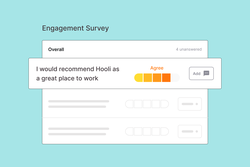
Article

There are many different types of employee surveys to gather employee feedback, from engagement to onboarding, exit, and beyond. Regardless of which one you use, the survey questions you ask are the most visible and often memorable part of an employee survey.
Deciding on your questions (and how to ask them) is important because you can only take action on what you ask. When people understand your questions, it's easier to answer openly and honestly, giving you better feedback to analyze and act on.
To help you out, we've compiled these 11 tips for writing great employee survey questions. If you put these tips into practice, you can more easily get the information you need to make the best decisions.
This person understands the survey strategy and purpose. They're responsible for collecting feedback on the questions from relevant people within your company. Having one decision-maker in charge of understanding the purpose behind each question keeps the process concise.
It’s tempting to dive into writing questions right away, but each question needs to have a purpose, and that purpose is defined by the objectives. Take a look at what systems and initiatives you already have in place, and consider what you are planning for the future.
Ask yourself, “What has been critical to our success?” If you’re using a survey template and find some questions irrelevant, rewrite them so they become useful. Your company is unique, and your survey questions should reflect that. It can be as simple as changing the language in questions from “manager” to “coach” if that’s how your company functions.
For example, Culture Amp refers to managers as "People leaders" and direct reports as "mentees."
Understand how someone answering your question processes the question in their mind. We’ll walk through what this looks like with the example: “I receive appropriate recognition for my work”
Each question you ask sends a signal to the employees of your organization. If the question is “My manager gives me feedback once a week,” it signals that once-a-week feedback is the norm. In choosing your questions, ensure you send the right signals on company norms.
Always include a midpoint in your Likert scale, because it accounts for people who feel neutral on a question. If you exclude a midpoint, your “favorable” sentiment becomes inflated as people tend to acquiesce to the “yes” or “positive” side of the scale rather than answering how they truly feel.
If the platform you’re using for your survey includes benchmarks, ensure you retain the questions where a benchmark is available. Asking benchmark questions enables you to compare your survey results to peers in your industry.
You're put in a difficult position if you ask a question about something you can’t change (or aren’t ready to discuss). Survey takers will expect that if you ask questions about compensation, for example, you’re willing to discuss or change something around this policy.
When designing a survey, it can be tempting to make certain questions mandatory. However, this can be frustrating and annoying for people who honestly can’t answer the question. Participation in a survey should be voluntary, and mandatory questions go against this principle.
You should understand the “why” behind each question, but not every question needs to be immediately actionable. You’re looking for questions that diagnose a problem on the whole, not necessarily solve it individually.
Survey fatigue can affect your survey’s results. If you’re asking about every aspect of your company in a 200-question survey, participants will likely get tired. Keep them interested and focused by ensuring the number of questions you ask is reasonable. Take the survey yourself to estimate the time it will take to complete. In general, we find that 10 minutes or less is ideal.
By applying these 11 tips to any of your employee surveys, you'll be able to glean the data and insights you need to make smart and strategic decisions.

For more specific tips on writing survey questions, check out these resources: